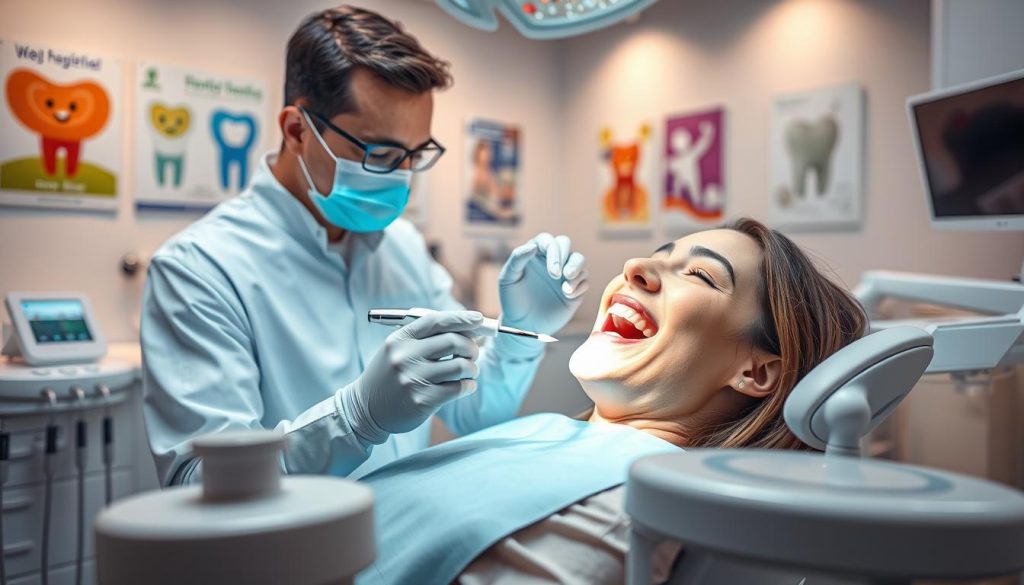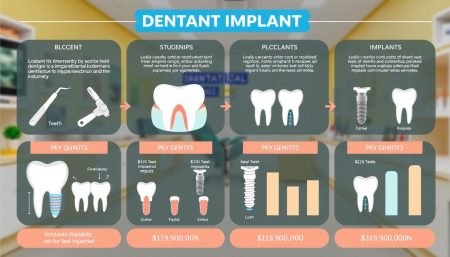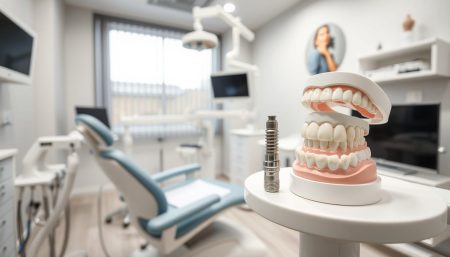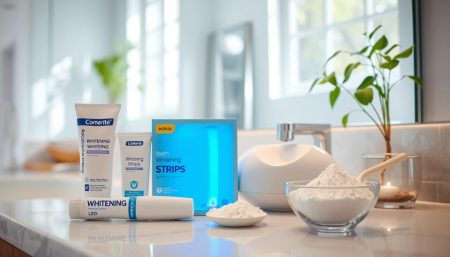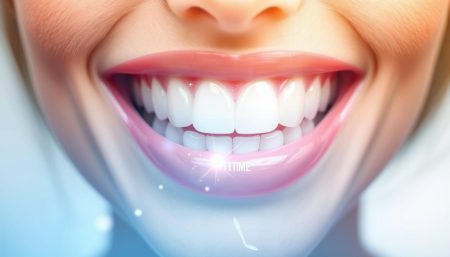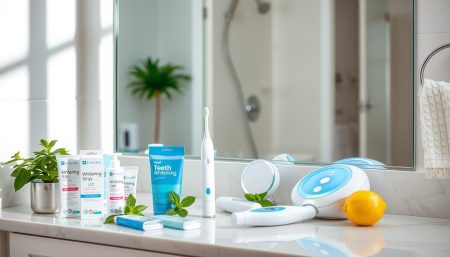Getting a dazzling, whiter smile is easier than ever with professional teeth whitening. This cosmetic procedure has become very popular. The American Dental Association says it’s safe and effective for white teeth.
Unlike many over-the-counter options, professional teeth whitening is more reliable. People trust the results more. Consumer reports show that professional treatments give a brighter, longer-lasting smile than DIY kits.
As more people want to improve their looks, the need for these services keeps growing. Getting a treatment from dental professionals means your smile will get brighter. It’s done in a way that fits your needs and dental health.
Key Takeaways
- Professional teeth whitening is endorsed by the American Dental Association for safe and effective results
- Contrary to DIY methods, professional treatments offer a more dependable whiter smile
- Meticulously managed by dental experts, this procedure is custom-fit to individual requirements and oral health
- Professional whitening is setting trends as the reliable choice for those seeking to enhance their smile
- Consumer reports highlight the superior outcomes of professional services compared to at-home whitening kits
The Importance of a Confident Smile
Research shows that a confident smile greatly boosts self-esteem and social skills. Feeling good about one’s smile can increase confidence. This confidence is key in personal and professional life. A bright, appealing smile is crucial, and brightening teeth is essential for this.
People with whiter teeth are seen as more successful and friendly. A study found that many felt more confident after dental whitening. This boost in self-perception improves life and relationships.
Dental whitening does more than make teeth look good. It also lifts one’s mood. This focus on health and looks makes people feel better and more confident.
Looking into the link between a bright smile and confidence shows that teeth whitening is more than looks. It’s a step towards personal growth and happiness.
What Is Professional Teeth Whitening?
Professional teeth whitening, also known as teeth bleaching, is a dentist-supervised treatment. It aims to make your teeth much whiter. These treatments use stronger agents than over-the-counter products, giving quick and noticeable results.
Understanding the Procedure
The process starts with a dentist checking your teeth’s health and discussing what you can expect. Next, a protective gel or rubber shield is applied to your gums. This protects them from the whitening agent.
The agent, with a high hydrogen peroxide content, is then applied to your teeth. Sometimes, a special light is used to make the agent work better. Each session lasts 30 to 90 minutes. You might need more than one visit to get the desired results.
After the treatment, your teeth will be noticeably lighter. This can make your smile brighter and boost your confidence.
The Benefits Over At-Home Kits
Dentists recommend professional teeth whitening over DIY kits for good reasons:
- Strength of Bleaching Agent: Professional solutions are stronger, leading to faster and better results.
- Safety and Supervision: Experienced professionals ensure the treatment is safe and fits your needs.
- Longevity of Results: Professional whitening can last years with proper care, unlike DIY kits.
Here’s a quick comparison of professional tooth whitening and at-home kits:
| Feature | Professional Teeth Whitening | At-Home Kits |
|---|---|---|
| Bleaching Agent Concentration | High | Low to moderate |
| Duration of Results | Up to 3 years | Several months |
| Supervision | By a dental professional | Self-applied |
| Cost per Treatment | Higher initial cost, less frequent need for retreatment | Lower initial cost, more frequent usage required |
Choosing professional teeth bleaching means safer, quicker, and longer-lasting results. It’s a smart investment in your smile and confidence.
The Science Behind Teeth Whitening
Many people want a brighter smile and look into tooth whiteners. The core of most whitening treatments is a chemical process. This process changes the color of tooth enamel without harming it. We’ll explore the science behind this bleaching process.
Tooth enamel is the hardest substance in our bodies but it’s also porous. This means stains from food, drinks, and smoking can get in. Hydrogen peroxide or carbamide peroxide are the main ingredients in tooth whiteners. They break down into oxygen radicals that get into the enamel and remove stains.
The bleaching process is more than just removing stains. It’s a controlled reaction that keeps the enamel healthy. New dental care innovations have made this process safer and more effective. Today’s whitening products can greatly improve your smile without harming your teeth.
The interaction between the bleaching agents and tooth enamel is delicate. A formula that’s too strong can damage the enamel, while one that’s too weak won’t work well. Dental professionals find the right balance, making professional whitening safe and effective.
In conclusion, tooth whitening is a result of modern dental science. By understanding how peroxides work on enamel, professionals can offer safe and effective treatments. This approach makes tooth whitening a safe and popular way to brighten your smile.
Choosing the Right Professional Whitening Treatment
Choosing the right teeth whitening can be tough. There are many options like laser whitening and custom-fit tray bleaching. Each has its own benefits. It’s important to talk to a dental professional to find the best fit for you.

A dental professional is key in picking the right whitening treatment. They look at how yellow your teeth are, if you have sensitive teeth, and your overall dental health. This helps make sure the treatment not only whitens your teeth but also keeps them healthy.
Now, let’s look at some popular whitening treatments:
- Laser Whitening: This uses a special gel and laser light. It’s fast and can whiten teeth in just one visit.
- Custom-fit Tray Bleaching: If you want a slower whitening, custom-fit trays might be for you. You wear a tray with bleaching gel at home, under a dentist’s watch.
Talking to your dental professional is crucial before choosing a treatment. They can tell you the good and bad of each option. They also make sure the treatment fits your needs and preferences, making it safer and more effective.
“Choosing the right whitening treatment can transform not just your smile but also your confidence.”
By making an informed choice with your dental professional, you can get the smile you want. And you’ll do it with the best care for your teeth.
What to Expect During a Teeth Whitening Session
Starting a teeth whitening journey is exciting. It’s a step towards a brighter smile. Knowing what happens during the session, how long it lasts, and the comfort and safety measures can make the experience better. This section will help you understand these aspects, making sure you have a great experience.
Duration of the Treatment
The time needed for a dental whitening session varies. It depends on how discolored your teeth are and the treatment you choose. Usually, it takes between 30 minutes to an hour. The procedure might be done several times to get the best results.
Dental experts use advanced techniques. They control the treatment’s duration and effects. This ensures every minute of the session helps in getting a whiter smile.
Comfort and Safety Measures
Dental professionals focus on your safety and comfort. They use barriers or gels to protect your gums and sensitive areas. This prevents irritation.
The latest equipment and methods are used to reduce discomfort or sensitivity. Adjustable lighting and chair settings make sure you’re comfortable during the procedure. Your dentist will also talk to you about any concerns or preferences before starting.
After the treatment, your dentist will give you tips on dental hygiene. They’ll also help with any sensitivity. This ensures your dental care continues well.
Teeth Whitening for Sensitive Teeth
For those with sensitivity, teeth whitening can seem scary. But, new dental care options offer gentle whitening for sensitive teeth. These methods aim to lessen pain while making your smile brighter.
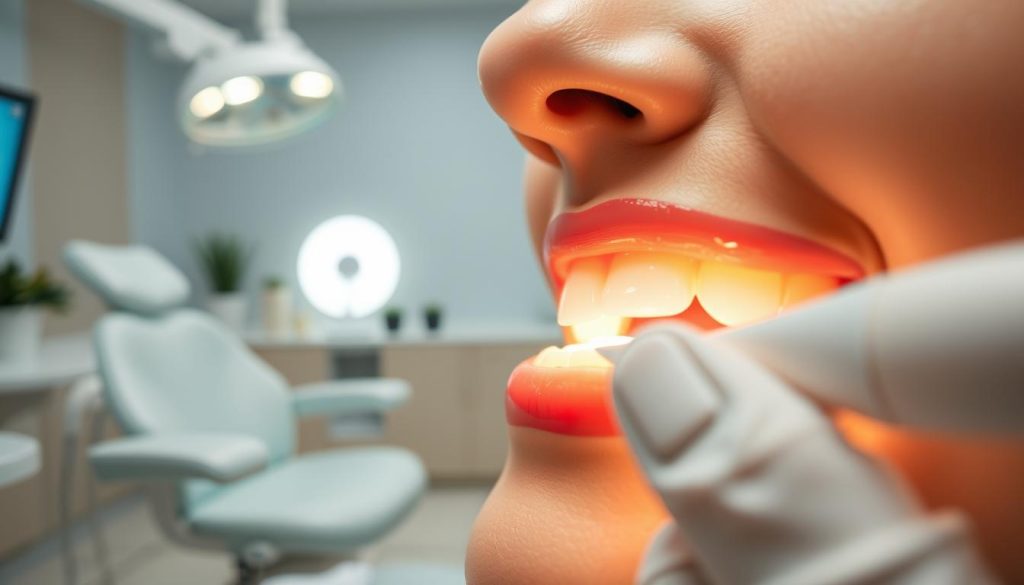
Gentle whitening products aim to lower the chance of pain during whitening. They use lower bleaching levels and add things like potassium nitrate. This helps reduce tooth sensitivity.
- Hydrogen Peroxide: Often used in lower amounts for sensitive teeth.
- Carbamide Peroxide: A slow-releasing bleaching agent that may cause less sensitivity.
- Potassium Nitrate: Found in many formulas to ease sensitivity.
The table below lists some popular gentle whitening products for sensitive teeth. It shows their active ingredients and benefits:
| Product | Active Ingredient | Benefits |
|---|---|---|
| Whitening Toothpaste A | Hydrogen Peroxide (low concentration) | Gently lifts stains with minimal irritation |
| Sensitive Whitening Strips B | Carbamide Peroxide | Provides gradual whitening with reduced sensitivity |
| Gentle Rinse C | Potassium Nitrate | Reduces tooth sensitivity during and after treatment |
If you have sensitive teeth, talk to your dentist before whitening. They can help pick the best gentle whitening option for you.
Caring for Your Teeth Post-Whitening
Keeping your smile bright after teeth whitening is easy. With the right care, you can keep your teeth looking great. Here are some tips from experts to help you.
Maintenance Tips
- Avoid staining foods and drinks like coffee, red wine, and berries for at least 48 hours after the treatment.
- Quit smoking or using tobacco products, which can yellow teeth.
- Use a whitening toothpaste twice a week to remove surface stains and prevent yellowing.
- Visit your dentist regularly for cleanings and check-ups to maintain oral health.
Recommended Oral Hygiene Routine
Having a good dental hygiene routine is key. It helps keep your teeth whitening results lasting longer.
- Brush twice a day with a fluoride toothpaste to fight cavities and decay.
- Floss daily to remove plaque from areas your toothbrush can’t reach.
- Consider using a mouthwash that targets discoloration, approved by dental professionals.
By following these tips, you can keep your teeth looking their best. And you’ll also keep your mouth healthy.
Teeth Whitening vs. Teeth Bleaching: Understanding the Difference
In dental cosmetics, ‘teeth whitening’ and ‘teeth bleaching’ are often mixed up. But they’re not the same. Knowing the difference is key to picking the right treatment for you.
Definitions and Effects
Teeth whitening means making teeth look cleaner by removing dirt. Teeth bleaching, however, uses chemicals to make teeth whiter than they naturally are. This is usually done with peroxide-based agents.
Choosing What’s Best for You
Deciding between whitening and bleaching depends on your dental health and beauty goals. Whitening is good for removing surface stains from food, drinks, or smoking. Bleaching is for those wanting a whiter smile than their natural one.
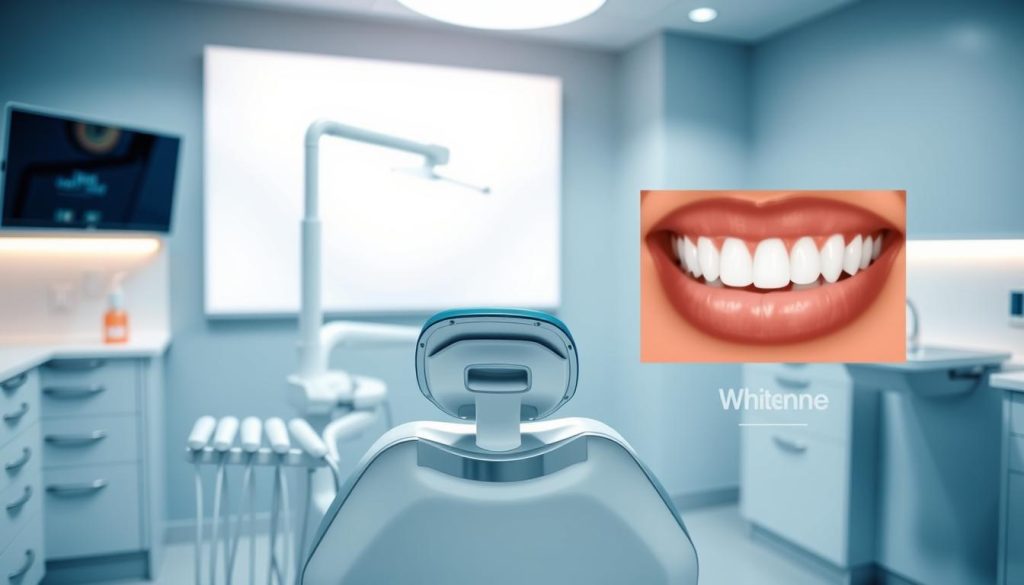
Talking to a dentist can help you choose the best option. They’ll consider your dental history and what you want. This way, you get the best treatment without harming your teeth.
Think about how long the results will last and if your teeth might get sensitive from bleaching. Choosing wisely helps keep your smile looking and feeling great.
The Longevity of Teeth Whitening Results
Understanding the lasting effects of professional teeth whitening starts with recognizing the relationship between treatment duration and final outcomes. While the immediate results can be striking, the long-term appearance of your smile depends heavily on several factors.
Lifestyle choices play a pivotal role in maintaining that radiantly white smile. Consuming staining substances like coffee, tea, and red wine, or smoking, can shorten the longevity of teeth whitening results. Regular dental hygiene practices and follow-up treatments can help extend these effects.
Studies have shown that the type of whitening treatment chosen also affects how long the results last. Options range from in-office laser treatments to custom-fitted home bleaching trays. Here’s a simple breakdown:
| Treatment Type | Average Longevity | Maintenance Required |
|---|---|---|
| In-office Laser Whitening | 1-3 years | Bi-annual touch-ups, daily oral care |
| Home Bleaching Trays | 6 months to 1 year | Monthly maintenance, avoidance of staining agents |
Additionally, post-whitening maintenance is crucial for extending the period of whiteness. Long-term observational studies suggest that with consistent care, the lasting effects of treatment can be maximized.
To summarize, the lasting effects of teeth whitening are contingent on both the treatment duration and diligent aftercare. By understanding these dependencies, patients can make informed decisions that ensure longer-lasting brightness.
Common Misconceptions About Teeth Whitening
Many people have myths about teeth whitening that might stop them from trying it. It’s important to know the truth to make good choices. We’ll clear up common myths and what you can really expect from teeth whitening.
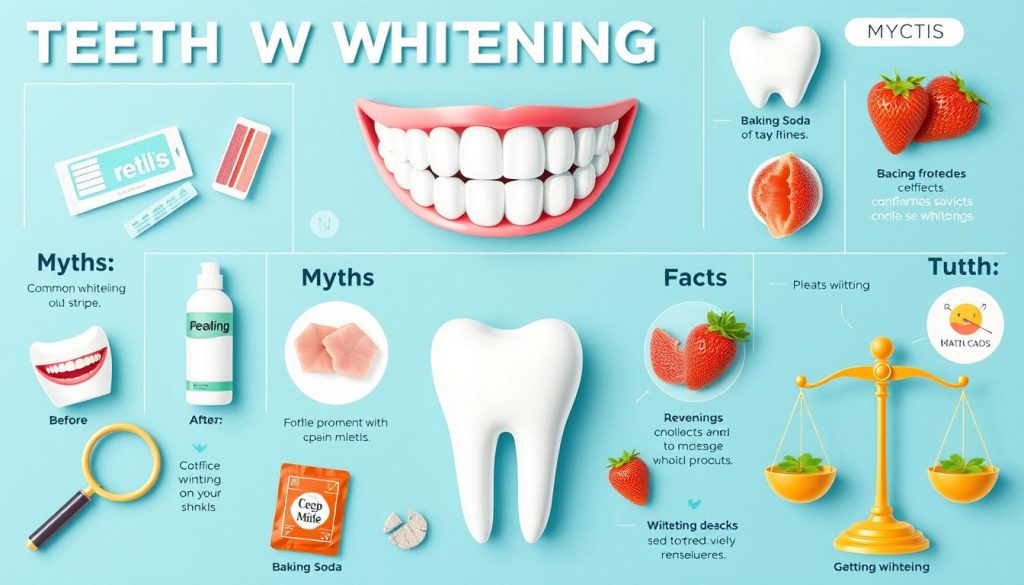
Myth Busting
- Whitening damages tooth enamel: A common myth is that whitening harms enamel. But, professional whitening agents are safe for enamel. They remove stains without harming the tooth.
- Home kits are as effective as professional treatments: Home whitening products can help, but they’re not as strong as professional ones. Professional treatments are faster and often give better results.
- Teeth whitening is a one-time procedure: Some think whitening is forever. But, it fades over time and needs touch-ups for lasting results.
Realistic Expectations for Treatment
It’s key to know what to expect from teeth whitening. Results can vary based on your teeth’s color and how you live. Here’s what to keep in mind:
- Initial tooth shade: Teeth with yellow tones usually get the best results. Brown or gray teeth might not bleach as much.
- Lifestyle factors: Smoking and eating foods like coffee and red wine can shorten whitening effects. Following your dentist’s care tips is important for keeping your teeth white.
By debunking myths and sharing teeth whitening facts, you can start your whitening journey with confidence and clear goals.
Natural Ways to Maintain a White Smile
Using natural care methods can greatly improve your oral health and keep your smile bright. Holistic dental care and the right nutrition are key to keeping your teeth looking good after whitening. Here are some top strategies and dietary tips for a naturally white smile.
Eating foods that are good for your teeth is a great way to protect and brighten your smile. Foods rich in calcium and phosphorus, like cheese and nuts, help strengthen tooth enamel. Crunchy fruits and veggies, such as apples and carrots, clean your teeth naturally by boosting saliva and gently scrubbing.
| Food Category | Benefits | Examples |
|---|---|---|
| Dairy Products | Rich in Calcium, Phosphorus | Cheese, Yogurt |
| Fruits & Vegetables | Natural Scrubbers, High in Fiber | Apples, Carrots |
| Herbal Teas | Neutralizes Acid Levels | Green Tea, Herbal Blends |
It’s also important to follow a routine that includes natural care for your teeth. Simple habits like rinsing with salt water or using a baking soda and coconut oil paste can help a lot. These practices not only keep your teeth healthy but also make whitening last longer.
- Use a straw for drinks like coffee or tea to avoid staining your teeth.
- Brush regularly with fluoride toothpaste to keep enamel strong and prevent stains.
- Make sure to visit your dentist every six months for a check-up to keep your oral health in top shape.
By choosing natural and thoughtful dental care, you not only keep your teeth white but also improve your overall health. Sticking to these natural methods ensures your smile stays bright and your teeth stay healthy for a long time.
Possible Side Effects of Teeth Whitening
When you want a brighter smile, it’s good to know about possible side effects. Many people choose teeth whitening for a shiny smile. But knowing what might happen can help you have a safe and comfortable experience.
Identifying Sensitivity Issues
One common side effect is tooth sensitivity. This feeling can be mild or strong and happens during or after treatment. It’s caused by the bleach agents that get into the enamel to remove stains.
But, if the sensitivity is really bad or lasts too long, you should see a dentist. They can help figure out if it’s just a normal side effect or something more serious.
When to Seek Dental Advice
Most people don’t worry about a little sensitivity after whitening. But, if you have a lot of pain, gum problems, or sensitivity that doesn’t go away, you need to talk to a dentist. They can suggest treatments like fluoride gels or special toothpaste to help.
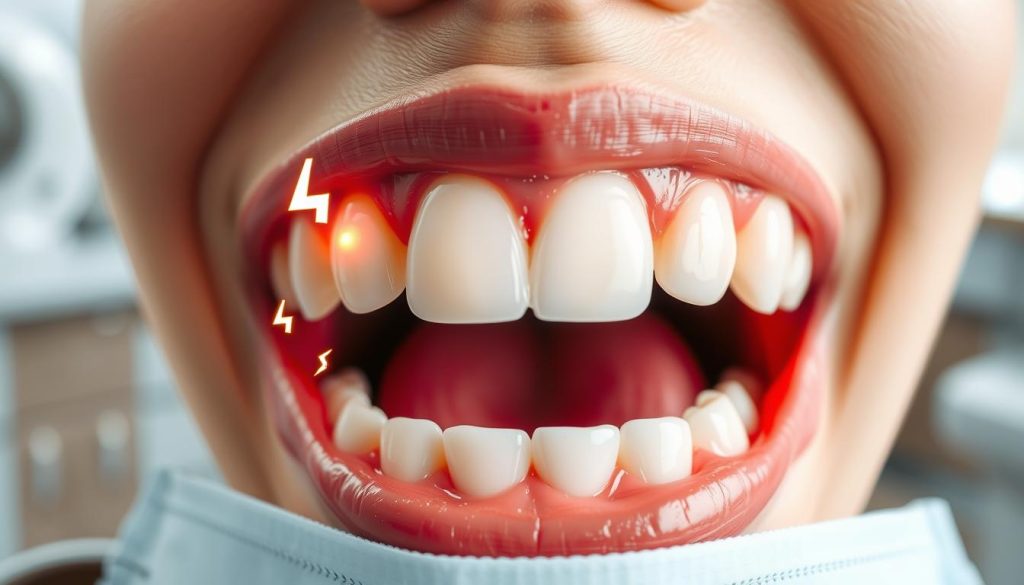
Seeing a dentist after whitening is not just for side effects. It’s also to keep your mouth healthy. Dentists can give advice based on your sensitivity and health history. This makes whitening safer and more effective.
Teeth Whitening and Oral Health: A Holistic Approach
Teeth whitening is more than just making your smile brighter. It’s a key part of comprehensive dental care. A balanced approach to oral health means combining whitening with other dental care steps.
Getting teeth whitening from a dentist is safe and keeps your teeth strong. It’s part of regular dental care. This shows how important a balanced approach is, where looks and health go hand in hand.
| Aspect | Contribution to Holistic Dental Care |
|---|---|
| Teeth Whitening | Improves aesthetic appeal and boosts self-confidence, motivating continued oral hygiene practices. |
| Regular Dental Check-ups | Ensures early detection of potential issues that can be aesthetically and functionally damaging. |
| Professional Cleaning | Removes plaque and tartar buildup, which can affect the whitening results and overall dental health. |
| Oral Hygiene Education | Encourages good daily habits, integral to maintaining the effects of teeth whitening and general dental health. |
Regular dentist visits and cleanings are key. They let you safely use whitening products. This keeps your teeth healthy and your smile bright.
Good oral health is more than just dentist visits. It’s about brushing, flossing, and eating right. These habits help your teeth stay healthy, which makes whitening safer and more effective.
So, teeth whitening is not just about a brighter smile. It’s about keeping your teeth and gums healthy. It’s the balanced approach that modern dentistry needs, focusing on both looks and health.
Teeth Whitening Trends and Innovations
The world of modern dentistry is always changing. Cutting-edge developments in teeth whitening lead the way in cosmetic dental care. These new technologies make teeth look better, feel more comfortable, and work faster. They help people smile brighter and feel more confident.
The Latest in Dental Whitening Technology
New advancements have changed how dentists whiten teeth. High-intensity lights and laser treatments are now key in making teeth whiter faster. They also make visits to the dentist shorter. Plus, new bleaching agents are safe for enamel and reduce sensitivity.
Emerging Products and Techniques
New teeth whitening products and methods are coming out fast. They show the ongoing research and people’s desire for the best results. There are nanotechnology whiteners that work faster and last longer, and at-home kits that you can customize for your needs.
- Nanohybrid peroxide gels target stains more efficiently, reducing the risk of gum irritation.
- Vitamin-infused whiteners that strengthen enamel while whitening.
- LED mouthpieces that can be controlled via smartphone apps to monitor progress.
This constant flow of new solutions is changing teeth whitening. It’s becoming more available and appealing to more people.
Conclusion
We’ve looked at how to get a dazzling smile through professional teeth whitening. We’ve learned about the science behind it and the many ways to make your teeth look better. A bright smile is something everyone wants, and professional whitening can help.
This method not only makes you feel more confident but also makes you happier with your teeth. Many people have said they feel better after getting their teeth whitened.
We also talked about the big difference between DIY whitening and getting it done by a pro. It’s important to get advice from a dentist, especially if you have sensitive teeth. A bright smile is not just about looks; it’s also good for your health.
New technologies are making it easier to keep your teeth white. As we wrap up, remember to talk to a dentist before trying any whitening treatments. They can help you find the best option for your teeth and health.
Getting a dazzling smile is more than just looking good. It shows you care about your dental health and hygiene. So, let’s keep working on our smiles and our overall health.
FAQ
Q: Why is professional teeth whitening more effective than over-the-counter products?
A: Professional teeth whitening uses stronger bleaching agents. These can only be safely applied by a dentist. This leads to better and more noticeable results than over-the-counter products. The American Dental Association also checks and approves some professional whitening methods, making them safe and effective.
Q: How can teeth whitening impact one’s confidence?
A: A brighter smile can make you feel more confident. Studies show that how we look, especially our smile, affects first impressions. People with whiter teeth are seen as more confident in social situations.
Q: What is the main advantage of choosing professional teeth whitening over at-home kits?
A: Professional teeth whitening is tailored to your needs by a dentist. This ensures safety and uses more effective agents for faster, longer-lasting results than at-home kits.
Q: What scientific principles are professional teeth whitening treatments based on?
A: Professional teeth whitening works by oxidation. Bleaching agents like hydrogen peroxide break down stains in tooth enamel. This makes your teeth appear whiter.
Q: How do dentists personalize professional whitening treatments for individual patients?
A: Dentists tailor treatments based on your dental health and staining level. They consider your cosmetic goals. Options like laser whitening and custom trays are chosen to fit your needs.
Q: What should clients expect during a professional teeth whitening session regarding duration and comfort?
A: Sessions last from 30 minutes to an hour, depending on the method. Dental offices make sure you’re comfortable with gum protection and manage sensitivity. They explain the process in detail beforehand.
Q: Are there teeth whitening options for those with sensitive teeth?
A: Yes, there are options for sensitive teeth. Products with lower bleaching concentrations and desensitizers are available. Dentists can adjust treatments to ensure comfort for sensitive teeth.
Q: What care should be taken after a teeth whitening treatment to maintain results?
A: After whitening, avoid staining foods and drinks. Brush and floss regularly. Use maintenance products as recommended by your dentist to keep your teeth white.
Q: How do teeth whitening and teeth bleaching differ?
A: Whitening removes stains from the tooth surface. Bleaching makes teeth whiter than their natural color using agents like hydrogen peroxide.
Q: How long do the results of teeth whitening treatments last?
A: Results vary based on the treatment, lifestyle, and post-care. Professional whitening can last months to years.
Q: Can teeth whitening damage enamel?
A: Professional whitening is safe and doesn’t harm enamel. The agents used are effective without damaging the tooth structure.
Q: What natural methods can help maintain a white smile after professional treatment?
A: Eat a balanced diet, brush and floss regularly. Use natural cleaners like baking soda or hydrogen peroxide in moderation.
Q: What are the possible side effects of teeth whitening?
A: Common side effects include temporary tooth sensitivity. Gum irritation or uneven whitening can occur but are rare with proper dental care.
Q: How does teeth whitening fit into overall oral health?
A: Whitening is part of a broader oral health plan. Regular dental visits and good hygiene are key. Whitening should complement, not replace, routine dental care.
Q: What are some of the latest trends and innovations in teeth whitening?
A: New trends include LED lights to boost bleaching, new peroxide formulas for less sensitivity, and natural whitening methods for a holistic approach.












